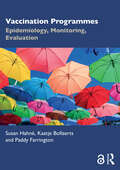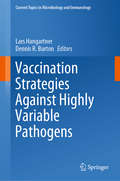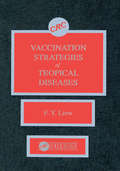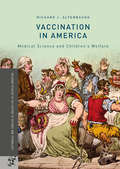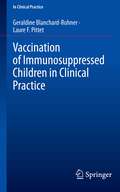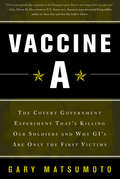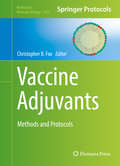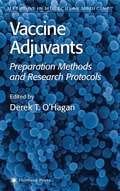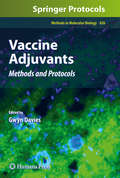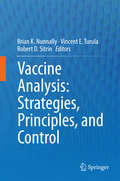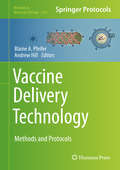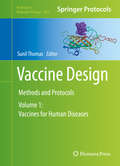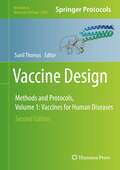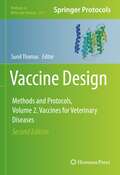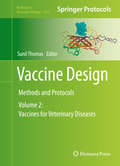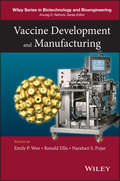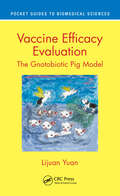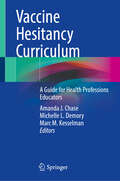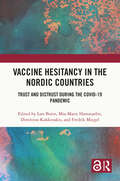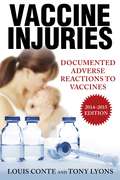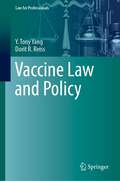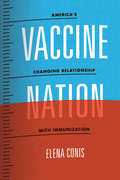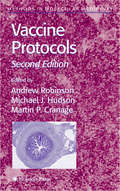- Table View
- List View
Vaccination Programmes: Epidemiology, Monitoring, Evaluation
by Paddy Farrington Susan Hahné Kaatje BollaertsVaccination programmes are of vital importance to public health and are present in virtually every country in the world. By promoting an understanding of the diverse effects of vaccination programmes, this textbook discusses how epidemiologic methods can be used to study, in real life, their impacts, benefits and risks. Written by expert practitioners in an accessible and concise style, this book is interspersed with practical examples which allow readers to acquire understanding through real-life data and problems. Part I provides an overview of basic concepts in vaccinology, immunology, vaccination programmes, infectious disease transmission dynamics, the various impacts of vaccination programmes and their societal context. Part II covers the main field tools used for the epidemiological evaluation of vaccination programmes: monitoring coverage and attitudes towards vaccination, surveillance of vaccine-preventable diseases and pathogens, seroepidemiological studies, methods to assess impact and outbreak investigation. Part III is dedicated to vaccine effectiveness and its assessment. Part IV includes an overview of the potential risks of vaccination and how to study these. Lastly, Part V deals with methods for an integrated assessment of benefits and risks of vaccination programmes. Suitable for professionals working in public health, epidemiology, biology and those working in health economics and vaccine development, Vaccination Programmes also serves as a textbook for postgraduate students in public health, epidemiology and infectious diseases. The book is aimed at all those involved in the many aspects of vaccination programmes, including public health professionals and epidemiologists. Its primary target audiences are master and doctoral students in infectious disease epidemiology and public health, post-doctoral participants of field epidemiology training programmes and public health professionals working in the post-implementation epidemiological evaluation of vaccines and vaccination programmes. The Open Access version of this book, available at http://www.taylorfrancis.com, has been made available under a Creative Commons Attribution-Non Commercial-No Derivatives (CC-BY-NC-ND) 4.0 license
Vaccination Strategies Against Highly Variable Pathogens (Current Topics in Microbiology and Immunology #428)
by Dennis R. Burton Lars HangartnerVaccines against antigenically stable pathogens, or pathogens that only exist in a limited number of serotypes, have been very successful in the past and have drastically decreased the incidence and lethality of many diseases. However, when it comes to highly variable pathogens or viruses that exist in multiple serotypes, the traditional methods for vaccine development have reached their limits.This volume highlights the development of vaccines against such challenging pathogens. Novel approaches for immunogen design, including structure-guided vaccine development and vaccines targeting glycans, as well as adjuvants and animal models used for testing possible vaccine candidates are outlined and discussed in detail. Given its scope, the book will appeal to scientists in the fields of infectious diseases, microbiology and medicine.
Vaccination Strategies of Tropical Diseases
by F.Y. LiewThis work in the field of tropical medicine provides an in-depth review in the development of vaccines against some of the most debilitating tropical diseases. In this multi-contributed, three-part book, with clear and ample illustrations, the reader will gather useful data and guidance to further his study in the field.
Vaccination in America: Medical Science and Children’s Welfare (Palgrave Studies in the History of Science and Technology)
by Richard J. AltenbaughThe success of the polio vaccine was a remarkable breakthrough for medical science, effectively eradicating a dreaded childhood disease. It was also the largest medical experiment to use American schoolchildren. Richard J. Altenbaugh examines an uneasy conundrum in the history of vaccination: even as vaccines greatly mitigate the harm that infectious disease causes children, the process of developing these vaccines put children at great risk as research subjects. In the first half of the twentieth century, in the face of widespread resistance to vaccines, public health officials gradually medicalized American culture through mass media, public health campaigns, and the public education system. Schools supplied tens of thousands of young human subjects to researchers, school buildings became the main dispensaries of the polio antigen, and the mass immunization campaign that followed changed American public health policy in profound ways. Tapping links between bioethics, education, public health, and medical research, this book raises fundamental questions about child welfare and the tension between private and public responsibility that still fuel anxieties around vaccination today.
Vaccination of Immunosuppressed Children in Clinical Practice (In Clinical Practice)
by Geraldine Blanchard-Rohner Laure F. PittetThis book provides cutting-edge information on the vaccination of children treated with various immunosuppressive regimens. The latest literature and recommendations on vaccination in immunosuppressed children are discussed in detail, providing practical guidelines on vaccination for specialists caring for immunosuppressive paediatric patients. Vaccination of Immunosuppressed Children in Clinical Practice is a clinically-focused synthesis for a wide audience of paediatricians around the world. Paediatricians (including rheumatologists, gastroenterologists, immunologists, neurologists, nephrologists, oncologists, haematologists) will find this book to be an essential resource for their daily clinical practice.
Vaccine A: The Covert Government Experiment That's Killing Our Soldiers -- and Why GI's Are Only the First Victims
by Gary MatsumotoIn this provocative look at the US military from the Persian Gulf War through the 2003 invasion of Iraq, investigative journalist Gary Matsumoto contends that an anthrax vaccine dispensed by the Department of Defense was the cause of Gulf War Syndrome and the origins of a massive cover-up. Matsumoto calls it the worst friendly-fire incident in military history. A skillfully-woven narrative that serves as a warning about this man-made epidemic, Vaccine A is a much needed account of just what went wrong, and why.
Vaccine Adjuvants
by Christopher B. FoxThis collection seeks to elucidate the practical methods necessary for successful adjuvant development, with a particular focus on the synthesis, formulation, manufacturing, and characterization aspects involved. Beginning with an overview and a case study, the book then delves into in silico design, chemical synthesis, biosynthesis, and/or purification from natural raw materials of specific adjuvant molecules, adjuvant formulation approaches, the analytical characterization of adjuvant formulations and adjuvant-containing vaccines, as well as the biological characterization of vaccine adjuvant activity, including in vitro and in vivo approaches, to measure innate and adaptive immune responses. Written in the highly successful Methods in Molecular Biology format, chapters include introductions to their respective topics, lists of the necessary materials and reagents, step-by-step, readily reproducible laboratory protocols, and tips on troubleshooting and avoiding known pitfalls. Practical and authoritative, Vaccine Adjuvants: Methods and Protocols aims to facilitate vaccine adjuvant product development efforts, making them more accessible, manufacturable, and better characterized.
Vaccine Adjuvants
by Derek T. O’haganDerek T. O'Hagan and a team of expert vaccinologists and pharmacologists thoroughly describe the preparation, characterization, and evaluation of a wide range of alternative vaccine adjuvants for use in preclinical studies. Each chapter carefully reviews a single adjuvant, and suggests why a specific adjuvant might be preferred for a given antigen, depending on what type of immune response is desired. Alternate adjuvant choices are also presented so that researchers can choose those most efficacious for their specific purpose. Comprehensive and highly practical, Vaccine Adjuvants: Preparation Methods and Research Protocols provides an effective guide to making and using vaccine adjuvants. By closely following directions from the book, today's researchers will be able optimally to induce specific immune responses against different types of antigens and to selectively manipulate the immune response in a favorable way.
Vaccine Adjuvants
by Gwyn DaviesSpanning from discoveries in fundamental immunology to industrial and commercial concerns, the study of vaccine adjuvants has developed into an exciting area of work with great, vital potential in innovating techniques in which adjuvants may steer the immune system towards the responses required by unmet vaccination needs. In Vaccine Adjuvants: Methods and Protocols, expert researchers in the field provide clear and concise guidance on how to go about assessing the activity of adjuvant products. Rather than describing individual adjuvants, the volume strives to include detailed, practical information on measuring the responses produced by adjuvants in order to be relevant to the widest array of experiments. Written in the highly successful Methods in Molecular BiologyTM series format, chapters include introductions to their respective topics, lists of the necessary materials and reagents, step-by-step, readily reproducible laboratory protocols, and notes on troubleshooting and avoiding known pitfalls. Authoritative and versatile, Vaccine Adjuvants: Methods and Protocols will enable those already pursuing vaccine adjuvant research, while also serving to stimulate discussion on how to best standardize adjuvant testing in order to facilitate meaningful comparisons, and above all, to aid in the prediction of which new products will most effectively and safely help to solve the current challenges in vaccination.
Vaccine Analysis: Strategies, Principles, and Control
by Brian K. Nunnally Vincent E. Turula Robert D. SitrinThis book is an indispensable tool for anyone involved in the research, development, or manufacture of new or existing vaccines. It describes a wide array of analytical and quality control technologies for the diverse vaccine modalities. Topics covered include the application of both classical and modern bio-analytical tools; procedures to assure safety and control of cross contamination; consistent biological transition of vaccines from the research laboratory to manufacturing scale; whole infectious attenuated organisms, such as live-attenuated and inactivated whole-cell bacterial vaccines and antiviral vaccines using attenuated or inactivated viruses; principles of viral inactivation and the application of these principles to vaccine development; recombinant DNA approaches to produce modern prophylactic vaccines; bacterial subunit, polysaccharide and glycoconjugate vaccines; combination vaccines that contain multiple antigens as well as regulatory requirements and the hurdles of licensure.
Vaccine Communication Online: Counteracting Misinformation, Rumors and Lies
by David Weiss Tamar Ginossar Sayyed Fawad Ali ShahCommunication about vaccination has become a public battleground. The global adoption of social media has increased the visibility and influence of groups that were previously considered fringe. With the goal of understanding vaccination-related misinformation’s online spread and ways of effectively countering it, this book explores its reception, resistance, and reproduction by a range of stakeholders around the globe. Chapters cover a rich array of topics, including vaccine misinformation’s history, its use as political propaganda, and its manipulation by both pro- and anti-vaccine groups. They apply a wide range of research methods, including historical literature and scoping reviews; advanced computational analysis, including machine learning; and reviews that incorporate the authors’ personal, professional, and practice-based experiences. Chapter authors include leading US and international scholars as well as practitioners of Communication, Computer Science, Health and Science Education, Political Communication, Public Health, Sociology, and other fields, making this book the most comprehensive and diverse collection of studies on vaccine misinformation—online and offline—currently available.
Vaccine Delivery Technology: Methods and Protocols (Methods in Molecular Biology #2183)
by Andrew Hill Blaine A. PfeiferThis volume discusses the vaccine development process and the role delivery concepts contribute to a global goal of effective health outcomes. The chapters in this book cover a wide range of topics such as antigen discovery methods; genetic and protein antigen preparation; preparation of viral vaccines as VLPs; viral and non-viral gene delivery; needle-less or non-invasive delivery technology; vaccine storage; and vaccine administration and assessment. Written in the highly successful Methods in Molecular Biology series format, chapters include introductions to their respective topics; lists of the necessary materials and reagents; step-by-step, readily reproducible laboratory protocols; and tips on troubleshooting and avoiding known pitfalls.Cutting-edge and practical, Vaccine Delivery Technology: Methods and Protocols is a valuable resource for both novice and expert researchers, in and outside the field, who would like to gain insight into the impactful field of vaccines. Chapter 7 is available open access under a Creative Commons Attribution 4.0 International License via link.springer.com.
Vaccine Design
by Sunil ThomasThis text provides a practical guide providing step-by-step protocol to design and develop vaccines. Chapters detail protocols for developing novel vaccines against infectious bacteria, viruses, fungi, and parasites for humans and animals. Volume 1: Vaccines for Human Diseases has an introductory section on how vaccines impacted diseases, the immunological mechanism of vaccines, future challenges for vaccinologists, and current trends in vaccinology. The design of human vaccines for viral, bacterial, fungal, parasitic and prion diseases as well as vaccines for drug abuse, allergy, and tumor vaccines are also described in this volume. As a volume in the highly successful Methods in Molecular Biology series, chapters contain introductions to their respective topics, lists of the necessary materials and reagents, step-by-step, readily reproducible protocols, and tips on troubleshooting and avoiding known pitfalls. Authoritative and practical, Vaccine Design: Methods and Protocols, Volume 1: Vaccines for Human Diseases aims to ensure successful results in the further study of this vital field.
Vaccine Design: Methods and Protocols, Volume 1. Vaccines for Human Diseases (Methods in Molecular Biology #2410)
by Sunil ThomasThis volume provides a practical guide providing step-by-step protocol to design and develop vaccines for human diseases. Divided into three volumes, Volume 1: Vaccines for Human Diseases guides readers through an introductory section on future challenges for vaccinologists and the immunological mechanism of vaccines. Chapters focus on design of human vaccines for viral, bacterial, fungal, and parasitic diseases as well as tumor vaccines. Written in the format of the highly successful Methods in Molecular Biology series, each chapter includes an introduction to the topic, lists necessary materials and reagents, includes tips on troubleshooting and known pitfalls, and step-by-step, readily reproducible protocols. Authoritative and practical, Vaccine Design: Methods and Protocols, Second Edition, Volume 1: Vaccines for Human Diseases aims to be a useful practical guide to researchers to help further their study in this field.
Vaccine Design: Methods and Protocols, Volume 2. Vaccines for Veterinary Diseases (Methods in Molecular Biology #2411)
by Sunil ThomasThis volume provides a practical guide providing step-by-step protocol to explore vaccines for farm and companion animals, as well as for fish and insects. Divided into three volumes, Volume 2: Vaccines for Veterinary Diseases guides readers through veterinary vaccines, vaccines for poultry, vaccines for farm animals, and vaccines for veterinary parasites. Written in the format of the highly successful Methods in Molecular Biology series, each chapter includes an introduction to the topic, lists necessary materials and reagents, includes tips on troubleshooting and known pitfalls, and step-by-step, readily reproducible protocols. Authoritative and practical, Vaccine Design: Methods and Protocols, Second Edition, Volume 2: Vaccines for Veterinary Diseases aims to be a useful practical guide to researchers to help further their study in this field.
Vaccine Design: Methods and Protocols, Volume 2: Vaccines for Veterinary Diseases (Methods in Molecular Biology #1404)
by Sunil ThomasThis text provides a practical guide providing step-by-step protocol to design and develop vaccines. Chapters detail protocols for developing novel vaccines against infectious bacteria, viruses, fungi, and parasites for humans and animals. Volume 1: Vaccines for Human Diseases has an introductory section on how vaccines impacted diseases, the immunological mechanism of vaccines, future challenges for vaccinologists, and current trends in vaccinology. The design of human vaccines for viral, bacterial, fungal, parasitic and prion diseases as well as vaccines for drug abuse, allergy, and tumor vaccines are also described in this volume. As a volume in the highly successful Methods in Molecular Biology series, chapters contain introductions to their respective topics, lists of the necessary materials and reagents, step-by-step, readily reproducible protocols, and tips on troubleshooting and avoiding known pitfalls. Authoritative and practical, Vaccine Design: Methods and Protocols, Volume 1: Vaccines for Human Diseases aims to ensure successful results in the further study of this vital field.
Vaccine Development and Manufacturing
by Narahari S. Pujar Ronald Ellis Emily P. WenVaccine Manufacturing and Production is an invaluable reference on how to produce a vaccine - from beginning to end - addressing all classes of vaccines from a processing, production, and regulatory viewpoint. It will provide comprehensive information on the various fields involved in the production of vaccines, from fermentation, purification, formulation, to regulatory filing and facility designs. In recent years, there have been tremendous advances in all aspects of vaccine manufacturing. Improved technology and growth media have been developed for the production of cell culture with high cell density or fermentation. Vaccine Manufacturing and Production will serve as a reference on all aspects of vaccine production by providing an in-depth description of the available technologies for making different types of vaccines and the current thinking in facility designs and supply issues. This book will provide insight to the issues scientists face when producing a vaccine, the steps that are involved, and will serve as a reference tool regarding state-of-the-art vaccine manufacturing technologies and facility set-up.Highlights include:Comprehensive coverage of vaccine production : from a process point of view- fermentation to purification to formulation developments; from a production point of view - from facility design to manufacturing; and from a regulatory point of view - requirements from government agenciesAuthors from different major pharmaceutical and biotechnology companiesDescribes the challenges and issues involved in vaccine production and manufacturing of the different classes of vaccines, an area not covered by other books currently on the market
Vaccine Efficacy Evaluation: The Gnotobiotic Pig Model (Pocket Guides to Biomedical Sciences)
by Lijuan YuanTesting the immunogenicity, protective efficacy and safety in animal models is a crucial step in vaccine development. Pigs raised in germ-free environments, called gnotobiotic (Gn) pigs, are one of the most useful animal models for testing vaccines. The Gn pig model is a widely accepted model for studying pathogenesis and immunity and an ideal model for pre-clinical testing for the safety and efficacy of enteric viral vaccines. Through these studies and others, the Gn pig model has been established as the most reliable animal model for pre-clinical evaluation of human rotavirus and norovirus vaccines. This book provides detailed information on establishing Gn pig models, determining a proper virus inoculum pool and challenge dose, measuring protection and calculating efficacy, and delineating intestinal and systemic immune responses associated with the protection.Key Features Provides a natural history of human rotavirus and norovirus infection in Gn pigs Establishes the optimal virus challenge doses in Gn pigs for vaccine evaluation Evaluates various candidate rotavirus and norovirus vaccines Discusses human gut microbiota transplanted Gn pig models Documents the role of probiotics and rice bran as prophylactics and vaccine adjuvants
Vaccine Hesitancy Curriculum: A Guide for Health Professions Educators
by Amanda J. Chase Michelle L. Demory Marc M. KesselmanVaccination is considered one of humanity&’s most transformative medical breakthroughs, with its origins tracing back to Edward Jenner&’s groundbreaking smallpox vaccine in the late 18th century. Though early skepticism of vaccines was formidable, rigorous scientific investigation and countless documented successes established vaccination as a cornerstone of modern medicine. For generations, vaccination was considered one of the surest ways to prevent death and suffering from infectious diseases, fundamentally reshaping global public health outcomes. However, advances in social networking and the influence of an anti-vaccination movement have reignited vaccine hesitancy on a scale not seen since the pre-modern era. Empowering healthcare providers with the skills to engage in meaningful dialogue with patients and the community about vaccines is paramount to addressing vaccine hesitancy and rebuilding public trust in vaccination programs. This comprehensive book first lays a foundation for understanding vaccine hesitancy by exploring the historical sources of mistrust in vaccines and science. Subsequent chapters highlight evidence-based approaches to cultivate communication skills and foster meaningful dialogue in patient interactions, while emphasizing empathetic practice and self-reflection in health professions trainees. Beyond theoretical foundations, it provides practical tools and strategies for addressing the most challenging aspects of vaccine communication. When these communication principles are thoughtfully applied in clinical settings, they become powerful tools for combating misinformation, dismantling deeply held misconceptions, and nurturing patient trust.
Vaccine Hesitancy in the Nordic Countries: Trust and Distrust During the COVID-19 Pandemic
by Mia-Marie Hammarlin Lars Borin Dimitrios Kokkinakis Fredrik MiegelBringing together studies from across the Nordic region, this book examines the challenges brought by the COVID-19 pandemic, with a particular focus on vaccine hesitancy. Shedding light on the political tensions that emerged as a result of the pandemic and the debates that ensued both within and between the Nordic nations, it investigates the vociferous discussions surrounding the COVID-19 vaccines and their presumed negative side effects through the lens of trust; trust in and between the neighbouring countries, in healthcare systems, fellow citizens, and experts; in public authorities, politicians, researchers, journalists, and pharmaceutical companies. The first volume to explore vaccine hesitancy in the Scandinavian context, this ground-breaking volume offers fresh perspectives on vaccine scepticism not as a form of ignorance or lack of knowledge, but as a manifestation of a more fundamental lack of faith in modern government and science. As such, it will appeal to scholars of sociology, politics, anthropology, media studies, communication and cultural studies with interests in public health, popular and political discourse and questions of public trust.The Open Access version of this book, available at http://www.taylorfrancis.com, has been made available under a Creative Commons [Attribution-Non Commercial-No Derivatives (CC-BY-NC-ND)] 4.0 license.
Vaccine Injuries: Documented Adverse Reactions to Vaccines
by Tony Lyons Lou ConteReveals the truth behind the controversial issue of vaccine-related injuries.Proponents declare that vaccines have saved millions of lives. Critics claim that the success is overstated and that vaccines may even be dangerous. <P><P>Many consider mandatory vaccinations a violation of individual rights or religious principles. Many in public health argue that vaccine mandates are critical and justified and that antivaccination sentiment has resulted in outbreaks of preventable childhood illnesses. Vaccine critics point to mainstream medicine's denial of and underreporting of vaccine injury.Vaccine injuries have happened in the past and continue to happen today, and neither the mainstream medical establishment nor the government has ever fully and transparently addressed the issue of vaccine injury. In the 1980s, the United States addressed individual cases of vaccine injury by establishing the NVICP--the National Vaccine Injury Compensation Program--a controversial Department of Health and Human Services program. The NVICP was intended to be "non-adversarial, compassionate, and generous" to vaccine-injury victims. However, many vaccine-injury victims and safety advocates believe that the program is not functioning as intended. There are also concerns that the program is keeping the reality of vaccine injury from public inspection.Vaccine Injuries, a groundbreaking book in the field, reveals cases of vaccine injury from the NVICP--something that has never been offered to the public--and lets readers asses vaccine injuries for themselves.
Vaccine Law and Policy (Law for Professionals)
by Y. Tony Yang Dorit R. ReissVaccine Law and Policy is the first book on vaccine law and policy written specifically for the general public or an educated lay audience without legal background. It offers comprehensive but accessible coverage of key aspects of vaccine law and policy, from product development and intellectual property protections, to regulation, public mandates, and vaccine injury claims. The COVID-19 pandemic sparked a growing interest in learning more about vaccine law and policy, as vaccine development, access, safety and requirements became relevant to hundreds of millions of people worldwide. This book covers United States law in most detail, but the developments and trends described have parallels in many countries, and the United States model and its actions influence others. Some of the most widely used vaccines against COVID-19 - mRNA vaccines – were developed in the United States, and choices made in the United States impact other countries.United States law currently has so much to say about vaccines. From the federal mandate President Biden enacted requiring federal employees to be vaccinated against COVID-19, to the growing number of private employers requiring vaccines to return to work, vaccine law has become a prevalent topic in everyday life. But there is little writing about the legal aspects of vaccines directed at the general public or an educated lay audience without a legal background. Vaccine Law and Policy will not only be invaluable to professionals implementing vaccine law and policy, but also to regulators, public health officials, and scientific researchers.Vaccine Law and Policy covers the wide range of laws and policies that impact the field. These include, among others, regulatory oversight by the FDA, one of the most influential bodies in drug and vaccines regulation worldwide, enforcement, and regulation of the research and development of vaccines; vaccine mandates for children and in the workplace, and medical, religious, and philosophical exemptions to them; patent law and other intellectual property protections such as trademark, trade secret, unfair competition, and copyright law; compensation for vaccine injuries under the National Vaccine Injury Compensation Program (NVICP) and other avenues of liability; safety monitoring; access to vaccines, their promotion, and issues related to funding and costs. The book will also discuss issues related to anti-vaccine movements and vaccine advocacy.
Vaccine Nation: America's Changing Relationship with Immunization
by Elena ConisWith employers offering free flu shots and pharmacies expanding into one-stop shops to prevent everything from shingles to tetanus, vaccines are ubiquitous in contemporary life. The past fifty years have witnessed an enormous upsurge in vaccines and immunization in the United States: American children now receive more vaccines than any previous generation, and laws requiring their immunization against a litany of diseases are standard. Yet, while vaccination rates have soared and cases of preventable infections have plummeted, an increasingly vocal cross section of Americans have questioned the safety and necessity of vaccines. In Vaccine Nation, Elena Conis explores this complicated history and its consequences for personal and public health. Vaccine Nation opens in the 1960s, when government scientists--triumphant following successes combating polio and smallpox--considered how the country might deploy new vaccines against what they called the "milder” diseases, including measles, mumps, and rubella. In the years that followed, Conis reveals, vaccines fundamentally changed how medical professionals, policy administrators, and ordinary Americans came to perceive the diseases they were designed to prevent. She brings this history up to the present with an insightful look at the past decade’s controversy over the implementation of the Gardasil vaccine for HPV, which sparked extensive debate because of its focus on adolescent girls and young women. Through this and other examples, Conis demonstrates how the acceptance of vaccines and vaccination policies has been as contingent on political and social concerns as on scientific findings. By setting the complex story of American vaccination within the country’s broader history, Vaccine Nation goes beyond the simple story of the triumph of science over disease and provides a new and perceptive account of the role of politics and social forces in medicine.
Vaccine Nation: America's Changing Relationship with Immunization
by Elena Conis&“A strikingly honest, fair-minded, and informed chronicle of the vaccine controversy in the United States.&”—Age of Autism By setting the complex story of American vaccination within the country&’s broader history, Vaccine Nation goes beyond the simple story of the triumph of science over disease and provides a new and perceptive account of the role of politics and social forces in medicine.Vaccine Nation opens in the 1960s, when government scientists—triumphant following successes combating polio and smallpox—considered how the country might deploy new vaccines against what they called the &“milder&” diseases, including measles, mumps, and rubella. In the years that followed, Conis reveals, vaccines fundamentally changed how medical professionals, policy administrators, and ordinary Americans came to perceive the diseases they were designed to prevent. She brings this history up to the present with an insightful look at the past decade&’s controversy over the implementation of the Gardasil vaccine for HPV, which sparked extensive debate because of its focus on adolescent girls and young women. Through this and other examples, Conis demonstrates how the acceptance of vaccines and vaccination policies has been as contingent on political and social concerns as on scientific findings. In Vaccine Nation, Conis delivers &“a fascinating account of how routine childhood immunization came to be both a public health success story and a source of bitter controversy&” (James Colgrove, author of Epidemic City and State of Immunity). &“At a moment when, as Conis says, children&’s participation in public life depends on their immunization status, she favors a nuanced view of our complicated relationship with &‘the jab.&’&”—Los Angeles Times
Vaccine Protocols
by Martin P. Cranage Michael J. Hudson Andrew P. RobinsonThis extensively revised, updated, and expanded second edition of a classic laboratory manual applies new understanding of molecular mechanisms to the rational design and development of vaccines. Here the working researcher will find readily reproducible techniques for the development and production of live attenuated vaccines, and vaccines based on inactivated toxins, peptides, and polysaccharide conjugates. New to this edition are cutting-edge chapters on two different viral vectors (Vaccinia and Semliki Forest), lactic acid bacteria for delivery of foreign antigens, incorporation of immunomodulators into plasmid DNA vaccines, construction of tetramer complexes to detect CMI responses, assessment of functional antibody responses, and the use of complete genome sequences for vaccine design. There are also chapters describing more general techniques for vaccine formulation, delivery, and assessment of immune responses, and review discussions of scale-up to manufacture, vaccine quality assurance, and clinical trials.
